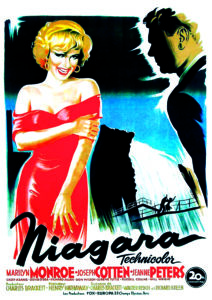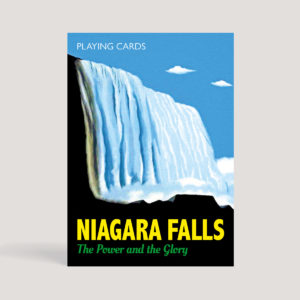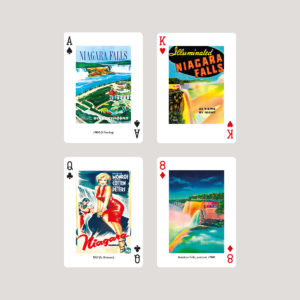‘Their roar is around me. I am on the brink of the great waters – and their anthem voice goes up amid the rainbow and the mist.’ Grenville Mellen, 1881
 Niagara Falls is a group of three waterfalls at the southern end of Niagara Gorge, spanning the border between New York State and Ontario. The falls – American Falls, Horseshoe Falls and the small Bridal Veil Falls – formed 12,000 years ago, when water from Lake Erie carved a channel to Lake Ontario. The name Niagara came from ‘Onguiaahra’, as the area was known to the Iroquois. It became famous throughout Europe after the intrepid French explorer Samuel de Champlain described the falls in 1604.
Niagara Falls is a group of three waterfalls at the southern end of Niagara Gorge, spanning the border between New York State and Ontario. The falls – American Falls, Horseshoe Falls and the small Bridal Veil Falls – formed 12,000 years ago, when water from Lake Erie carved a channel to Lake Ontario. The name Niagara came from ‘Onguiaahra’, as the area was known to the Iroquois. It became famous throughout Europe after the intrepid French explorer Samuel de Champlain described the falls in 1604.
 In the 19th century, a visit to Niagara Falls was an almost messianic experience. ‘At last, fortissimo!’ exclaimed Austrian composer Gustav Mahler. ‘When I felt how near to my Creator I was standing,’ wrote Charles Dickens in 1842, ‘the first effect, and the enduring one of the tremendous spectacle, was Peace.’ Alexis de Tocqueville wrote of ‘a profound and terrifying obscurity’ (1831). He sensed the falls were threatened when he urged a friend to ‘hasten [or] your Niagara will have been spoiled for you.’ Factories already encroached.
In the 19th century, a visit to Niagara Falls was an almost messianic experience. ‘At last, fortissimo!’ exclaimed Austrian composer Gustav Mahler. ‘When I felt how near to my Creator I was standing,’ wrote Charles Dickens in 1842, ‘the first effect, and the enduring one of the tremendous spectacle, was Peace.’ Alexis de Tocqueville wrote of ‘a profound and terrifying obscurity’ (1831). He sensed the falls were threatened when he urged a friend to ‘hasten [or] your Niagara will have been spoiled for you.’ Factories already encroached.
Niagara Falls today is part exploitation, part preservation (left alone, it would eventually disappear, through erosion). The Free Niagara Movement created a park around the site in the 1880s. In 1950, half the water from Niagara Falls was diverted through underwater tunnels to hydroelectric turbines during peak tourist hours. And at night the water flow is halved again (via 18 gates upstream). This diversion has helped reduce the rate of erosion by more than 85%. One historian calls Niagara ‘a completely man-made and artificial cataract’. In the 1960s both edges of Horseshoe Falls were excavated to create a photogenic crest.
Niagara has seen many dramatic stunts, the most famous being by the French acrobat and tightrope walker Blondin (Jean François Gravelet). In 1859, he crossed the Falls several times: blindfolded, in a sack, with a wheelbarrow, on stilts, carrying his manager – and sitting down midway and cooking an omelette (do not try this at home).
 In 1827, a local hotel owner sent a ship with a ‘cargo of ferocious animals’ over the falls – though ‘ferocious’ was hyperbole, the menagerie included a goose (the only animal to survive). In 1829, the daredevil Sam Patch (‘The Jersey Jumper’ or ‘The Yankee Leaper’) made two jumps (one of 120 feet) from below Goat Island. Repeating the feat on the Genesee River the same year proved a failure. His epitaph read ‘Such is Fame’. In 1901, Annie Taylor (aged 63) was the first person to conquer the falls in a barrel and live. She did it to get rich. She died in poverty. In 1911, Bobby Leach plunged over the waterfall in a steel barrel. He broke both kneecaps and his jaw.
In 1827, a local hotel owner sent a ship with a ‘cargo of ferocious animals’ over the falls – though ‘ferocious’ was hyperbole, the menagerie included a goose (the only animal to survive). In 1829, the daredevil Sam Patch (‘The Jersey Jumper’ or ‘The Yankee Leaper’) made two jumps (one of 120 feet) from below Goat Island. Repeating the feat on the Genesee River the same year proved a failure. His epitaph read ‘Such is Fame’. In 1901, Annie Taylor (aged 63) was the first person to conquer the falls in a barrel and live. She did it to get rich. She died in poverty. In 1911, Bobby Leach plunged over the waterfall in a steel barrel. He broke both kneecaps and his jaw.
Later, while touring New Zealand, Bobby slipped on an orange peel, and died. In 1920, an English chap called Charles Stephens tied himself to an anvil (used for ballast) in his wooden barrel. After the plunge, only his right arm was found. In 1930, Greek immigrant George Stathakis, hoping to raise money to publish his books on metaphysics, built a barrel weighing nearly a ton, and dropped over the edge with his mascot, a 100-year-old pet turtle, Sonny Boy. Sonny Boy survived. George didn’t.
About 5000 bodies have been found at the foot of the falls since 1850 (many were suicides). If you are thinking of a trip over Niagara Falls, take Annie Taylor’s advice. Don’t. She appears not to have enjoyed the experience. ‘I will never go over the Falls again,’ she said. ‘I would sooner walk up to the mouth of a cannon, knowing it was going to blow me to pieces…’


